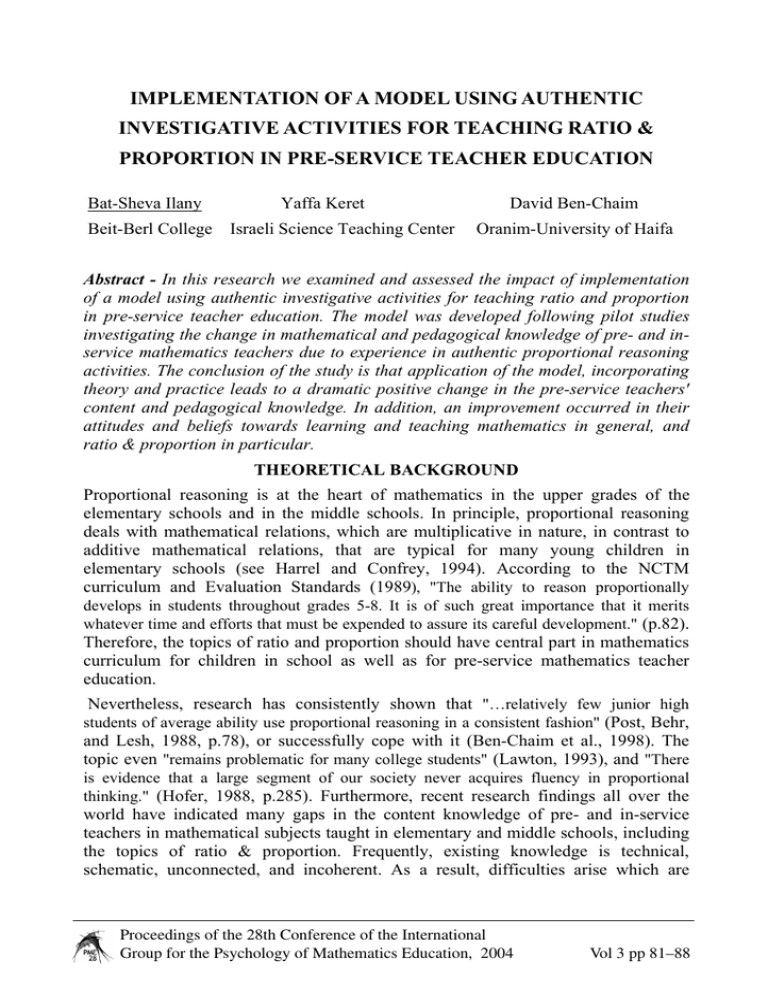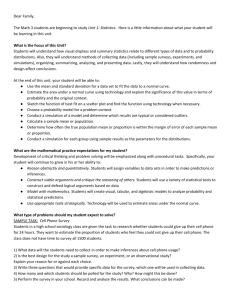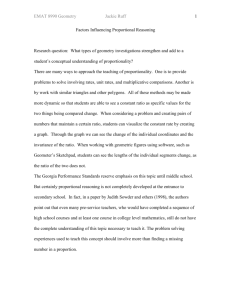IMPLEMENTATION OF A MODEL USING AUTHENTIC PROPORTION IN PRE-SERVICE TEACHER EDUCATION
advertisement

IMPLEMENTATION OF A MODEL USING AUTHENTIC INVESTIGATIVE ACTIVITIES FOR TEACHING RATIO & PROPORTION IN PRE-SERVICE TEACHER EDUCATION Bat-Sheva Ilany Beit-Berl College Yaffa Keret Israeli Science Teaching Center David Ben-Chaim Oranim-University of Haifa Abstract - In this research we examined and assessed the impact of implementation of a model using authentic investigative activities for teaching ratio and proportion in pre-service teacher education. The model was developed following pilot studies investigating the change in mathematical and pedagogical knowledge of pre- and inservice mathematics teachers due to experience in authentic proportional reasoning activities. The conclusion of the study is that application of the model, incorporating theory and practice leads to a dramatic positive change in the pre-service teachers' content and pedagogical knowledge. In addition, an improvement occurred in their attitudes and beliefs towards learning and teaching mathematics in general, and ratio & proportion in particular. THEORETICAL BACKGROUND Proportional reasoning is at the heart of mathematics in the upper grades of the elementary schools and in the middle schools. In principle, proportional reasoning deals with mathematical relations, which are multiplicative in nature, in contrast to additive mathematical relations, that are typical for many young children in elementary schools (see Harrel and Confrey, 1994). According to the NCTM curriculum and Evaluation Standards (1989), "The ability to reason proportionally develops in students throughout grades 5-8. It is of such great importance that it merits whatever time and efforts that must be expended to assure its careful development." (p.82). Therefore, the topics of ratio and proportion should have central part in mathematics curriculum for children in school as well as for pre-service mathematics teacher education. Nevertheless, research has consistently shown that "…relatively few junior high students of average ability use proportional reasoning in a consistent fashion" (Post, Behr, and Lesh, 1988, p.78), or successfully cope with it (Ben-Chaim et al., 1998). The topic even "remains problematic for many college students" (Lawton, 1993), and "There is evidence that a large segment of our society never acquires fluency in proportional thinking." (Hofer, 1988, p.285). Furthermore, recent research findings all over the world have indicated many gaps in the content knowledge of pre- and in-service teachers in mathematical subjects taught in elementary and middle schools, including the topics of ratio & proportion. Frequently, existing knowledge is technical, schematic, unconnected, and incoherent. As a result, difficulties arise which are Proceedings of the 28th Conference of the International Group for the Psychology of Mathematics Education, 2004 Vol 3 pp 81–88 evidence of the pre-service teachers' lack of understanding of mathematical concepts, including ration & proportion, and feeling that they are incapable of both, coping with the material, and teaching it (Keret 1999; Fischbein et al., 1994; Ben-Chaim, Ilany, and Keret, 2002). In a pilot study by Ben-Chaim, Ilany, and Keret (2001), nineteen activities were developed and conducted in order to assess the influence of exposing pre-service mathematics elementary teachers to authentic investigative proportional reasoning activities. Many of the activities are in the appropriate form for presentation to children in the upper classes of elementary school and in the classes of middle school. The activities include mathematical tasks, that require quantitative and qualitative numerical comparisons between ratios and finding a missing value. The tasks involve small and large integer numbers, fractions, decimals, and percents. The activities establish the understanding of many concepts related to ratio & proportion topics and are focused on the three main categories of proportional reasoning problems: Rate and Density, Ratio, and Scaling (see examples in figure 2). The findings of the pilot study showed that after exposing and experiencing with authentic ratio & proportion investigative activities, the pre-service teachers were more successful in solving ratio & proportion problems, exhibited different strategies for solving the problems, and were more capable of providing a good quality of written and oral explanations (during the interviews) to their work. In addition, they improved their attitudes toward mathematics in general and all the components and aspects of ratio & proportion in particular (Ben-Chaim et al., 2002). A replication of this study with several classes of pre-service teachers in 3 different colleges showed similar findings. From these research findings, the conclusion was that it is necessary to teach the ratio & proportion topics in pre- and in-service mathematics elementary and junior teacher education, by applying authentic investigative activities, such as those developed and conducted through the pilot study. As a result, a special model for teaching the ratio & proportion topics in mathematics teacher education was developed. The model incorporates the main areas in the training of pre-service teachers, particularly in the areas of content knowledge, pedagogical content knowledge, pedagogical reasoning, training, and beliefs. The model is comprised of 4 components with interaction between them (see figure 1). The first component - the core of the model includes the authentic investigative activities with 5 types of activities: Introductive activities, investigative activities dealing with ratio, dealing with rate, dealing with scaling, and dealing with indirect proportion. For each activity there is a basic part, to build the basic knowledge needed regarding ratio & proportion. Then, there is an extension part to further develop understanding (see figure 2). 3–82 PME28 – 2004 In parallel to the engagement in the investigative activities, the pre-service teachers are referred to articles, dealing with the topics of ratio & proportion. The articles are related to the mathematical as well as to the didactical-pedagogical aspects of the topics. The analysis of the research articles, enables the students to be aware of their mathematical knowledge, while the presentation of the research findings might lead to a wide perspective and deeper discussion regarding suitable teaching strategies for teaching the subject. In this case, the intention was to create an integration between theory and practice (Greeno, 1991,1994), or as Lienhardt et al. (1995) notation of "…knowledge learned in the academy vs. in practice". They claim that professional knowledge can vary by the location of the learning (in the academy or in practice), the type of knowledge (declarative or procedural), the generality of knowledge (abstract or specific), and the nature of principles (conceptual or pragmatic). Figure 1: A Model Using Authentic Investigative Activities For Teaching Ratio & Proportion Authentic Investigative Activities Activity Structure Introductive Activities Link Rate Activities Ratio Activities Fractions, Percentages Scale, etc. Scaling Activities Integration Didactical Unit Indirect Proportion Activities Evaluation Unit Ratio & Proportion Research Reports The second component includes the structure of the activities. They are structured as authentic investigative problems related to content and context familiar to the prospective teachers and to children in the elementary and junior level. In general the activities include types of tasks reported in the professional literature as appropriate for assessment for proportional reasoning (Cramer, Post, and Currier, 1993): (a) Missing value problems, where three pieces of information are given and the task PME28 – 2004 3–83 is to find the fourth or missing piece of information; (b) Numerical comparison problems, where two complete ratios/rates are given and a numerical answer is not required, but the ratios or rates are to be compared; (c) Qualitative prediction and comparison problems which require comparisons not dependent on specific numerical values. The third component includes the structure of the didactical unit. It includes a unit around a concept; for example: A didactical unit that its role to impart the concept of ratio. The structure of the didactical unit includes: (a) Working by groups; (b) Discussion of results with the whole class; (c) Mathematical and didactical summary; and (d) Homework. The fourth component includes the evaluation unit with several types of assessment instruments: (a) An instrument to evaluate student's mathematical knowledge, and mathematical didactical knowledge; (b) Attitude questionnaire; (c) Portfolio - An instrument for alternative assessment related to learning processes of pre-service prospective teachers during their studies; and (d) An instrument for assessing research reports during and after the course studies. For a detailed description of the model see Keret, Ben-Chaim, and Ilany (2003). The main goal of this paper is to report the results of an implementation of this model, in a pre-service teacher education course, in an Israeli teacher college, during the second semester of the academic year 2002/2003. METHODOLOGY Sample: 11 Pre-service teachers from the Israeli Teacher College as part of their training to teach mathematics in elementary and middle school. Research instruments: In addition to the model, the activities and the theoretical material (articles and research reports), the research instruments included: 1) A proportional reasoning questionnaire that was administered twice: First at the outset of the course and second at the end of the semester (14 weekly teaching sessions, each of 90 minutes). The questionnaire included 5 rate and density problems, 5 ratio problems, and 6 scaling problems. In each problem, the participants were asked to provide support work by giving reasons for their answers. For a full description of this instrument, see Ben-Chaim et al., (2002). 2) Attitude questionnaire, that includes 22 items and 3 open questions. The questionnaire was administered twice before and after the instruction. The items of the attitude questionnaire belong to four categories as presented in Table 4. For more details see Ben-Chaim et al. (2002). 3) Observations that were aimed at the formative evaluation of the model, and at the follow up of the pre-service teachers' procedures and change in behavior. 3–84 PME28 – 2004 4) Personal interviews that were aimed at in-depth examination of the participants opinions on the impact of the course. For this purpose, a representative sample of 3 participants were interviewed. The instructor of the course was one of the authors (Dr. Ilany). She implemented the model including all of its components using the teaching method of inquiry. RESULTS AND DISCUSSION The results of the quantitative analysis of the participants performance on the proportional reasoning questionnaire are presented in Table 1. The results indicate a very significant progress from pre- to post-test: 45% to 90%. The range on the pretest was 24%-74% and on the post-test 80%-100%. On each one of the subtests: Rate, Ratio, and Scaling the improvement was remarkable, 69% to 97%, 30% to 88%, and 36% to 86% accordingly. Even though the participants in this study started with lower achievement than in the previous study (Ben-Chaim et al., 2002), their improvement was much better. Another indication is a better quality of the explanations provided by the participants in this study, for their methods to solve the problems, especially after instruction. Table 1: Overall Pre-Post Results on 16 Problems (5 Rate, 5 Ratio, and 6 Scaling), N=11, Pre-service Mathematics Teachers Rate Ratio Scaling Total Pre 69% 30% 36% 45% Post 97% 88% 86% 90% The attitude questionnaire included items dealing with attitudes toward: Mathematics teaching in general, confidence in the ability to deal with ratio & proportion, difficulties in teaching ratio & proportion, and the importance of teaching ratio & proportion. Table 2 presents the pre-post results, that are quite similar to those presented and discussed in the previous study (Ben-Chaim et al., 2002). The data in Table 2 indicates that the pre-service teachers of this study improved their attitude toward teaching mathematics in general, even though they started with quite a positive level. In addition, they were much more confident in their ability to deal with ratio & proportion at the end of the course. Nevertheless there is a difference which is noticeable by the responses to the three open questions at the end of the attitude questionnaire, asking them to mention a situation of ratio, a situation of proportion, and to mention concepts and words that are related to the topics of ratio & proportion. In most cases, in the pre-test the preservice teachers wrote: "I don't remember", or "I don't know", especially for proportion. PME28 – 2004 3–85 Figure 2a: Investigative Problem 1: Preference of Cola BOLA-COLA OR COLA-NOLA? The following results are related to surveys of preference between BOLA-COLA and COLA-NOLA: A. The ratio of those who preferred BOLA-COLA than COLA-NOLA is 3 to 2. B. The numbers of those who preferred BOLA-COLA than COLA-NOLA are in ratio of 17,139 to 11,426. C. 5,713 more participants preferred BOLA-COLA than COLA-NOLA. 1. Decide if the above three statements are necessarily extracted from the same survey? Explain! 2. Which statement describes most accurately the results of comparison between BOLA-COLA and COLA-NOLA? Explain! 3. If you need to advertise the results, which statement seems to be the most effective for advertisement? Why? 4. Suggest other possible ways for comparison between the popularity results of the two kinds of cola. Figure 2b: Investigative Problem 2: Sharing Pizza Every month Danny's friends meet at a restaurant for a pizza party. Danny as usual is late, but his friends like him a lot and they are waiting for him to come. They reserved for him a seat in each of the two tables 1 and 2. Finally he arrived and then he had to decide where to sit: should he join his friends at Table 1 in which there are 4 large pizzas and 9 people or Table 2 in which there are 3 large pizzas and 7 people? Table 1 Table 2 1. What is your suggestion? Which table should Danny choose? Explain your reasoning. 2. The ratio of large tables (Table 1 with 10 seats) to small tables (Table 2 with 8 seats) in the restaurant is 9 to 5. There are exactly enough seats for 390 people. How many tables of each kind are in the restaurant? 3–86 PME28 – 2004 On the post-test, every one of the 11 participants provided several correct examples for ratio & proportion situations with indication of proper related concepts and words, and even using mathematical notations such as a / b � c / d , a, b, c, d � 0 . Table 2 : Summary of Attitudes Toward Ratio and Proportion Scale (1-5) Number of Mean Before Instruction Mean After Instruction items N = 11 N = 11 4 Items relating to attitudes toward teaching mathematics in general. 4.46 4.72 7 Items relating to confidence in ability to deal with ratio and proportion. 2.82 3.85 3 Items relating to attitudes toward difficulties in teaching ratio and proportion. 3.26 3.21 6 Items relating to attitudes toward the importance of teaching ratio and proportion. 4.65 4.40 The in-class observations and the in-depth interviews with the three representative participants, strongly supported the findings, suggesting that an implementation of the model with all of its components leads not only to acquiring mathematical content knowledge and pedagogical-didactical knowledge, but also, to a profound change in the pre-service teachers' opinions on teaching and learning mathematics. For example, the interviewees indicated that they liked the strategy of "not just to provide the answer, because it is possible to get there by a wrong procedure, hence one needs to add verbal explanations", or "I liked the strategy of inquiry, challenges, cooperation with colleagues, the activities were very interesting and can be presented to school children, the theoretical materials (articles and research reports) were very helpful", or "The activities, the theoretical material, and the guidance during the teaching sessions helped me to move from technical knowledge to a knowledge of understanding". It is interesting to note that most of the participants felt that the course should be longer, since they were not confident enough in their knowledge. In summary, the findings of this study prove that the implementation of the proposed model is appropriate for application in pre-service mathematics teacher education. During our presentation, the full model will be introduced and discussed; in addition, more data will be presented and the implication of the implementation of the model will be drawn. PME28 – 2004 3–87 SELECTED BIBLIOGRAPHY Ben-Chaim, D., Fay, J.t., Fitzgerald, M.W., Benedetto, C., and Miller, J (1998). Proportional reasoning among 7th grade students with different curricular experiences. Educational Studies In Mathematics, 36, 247-273. Ben-Chaim, D., Ilany, B., and Keret, Y. (2001). Ratio and Proportion - Mathematical and pedagogical knowledge of pre- and in- service elementary teachers, before and after learning these topics by a new approach. Research Report (In Hebrew), Mofet. Ben-Chaim, D., Ilany, B., and Keret, Y. (2002). Mathematical and pedagogical knowledge of pre- and in- service elementary teachers, before and after experience in proportional reasoning activities. In: Proceedings of the 26th International Conference for the Psychology of Mathematics Education, Vol. 2, pp. 81-88, Norwich, U.K.. Harel, G., and Confrey, J. (Eds). (1994). The Development of Multiplicative Reasoning in the Learning of Mathematics. SUNY Press. Hoffer, A. (1988). Ratios and proportional thinking. In: T. Post (ed.) Teaching mathematics in grades K-8: Research based methods. Boston: Allyn and Bacon, pp. 285-313. Keret, Y. (1999). Change processes in adult proportional reasoning: Student teachers and primary mathematics teachers, after exposure to ratio and proportion study unit. In: Proceedings of the 23rd International Conference for the Psychology of Mathematics Education, Vol. 3, pp. 145-152, Haifa, Israel. Keret, Y., Ben-Chaim, D., and Ilany, B. (2003) A model using authentic investigative activities for teaching ratio and proportion in pre-service elementary education. In: Proceedings of SEMT '03 - International Symposium Elementary Maths Teaching, pp. 94-99, Prague, Czech Republic. Greeno, J.G. (1994). Some further observations of the environment model metaphor. Journal of Research in Mathematics Education, 25(1), 94-99. Leinhardt, G., Young, K.M., and Merriman, J. (1995): Integrating professional knowledge: The theory of practice and the practice of theory. Learning and Instruction, Vol. 5, 401-408. 3–88 PME28 – 2004






